Back when the revolver was King, wheelgun shooters and manufacturers paid attention to details that are sometimes overlooked today. A great example of this, is the host of trigger and hammer options that were available back when sixguns still filled most of the duty holsters and won most of the matches.
Hammer time!
Consider the hammer on a double action revolver. While we’re not used to thinking of it as a menu item, there was a time when manufacturers such as Smith & Wesson offered several variations to choose from, based on the shooter’s needs.
If you were a target shooter, perhaps competing in the popular PPC or Bullseye matches, it was important for you to have a hammer with a spur that made it easy to cock the weapon. Since single action fire was a big part of these competitions, shooters wanted a hammer spur that was easy to reach and grip with their thumb. As a result, “target” hammers with longer, turned down spurs and large pads were favored, and offered by manufacturers on the models that competitors preferred. These hammers also showed up on hunting guns as well, since it was assumed that almost all shots in the field would be fired single action.
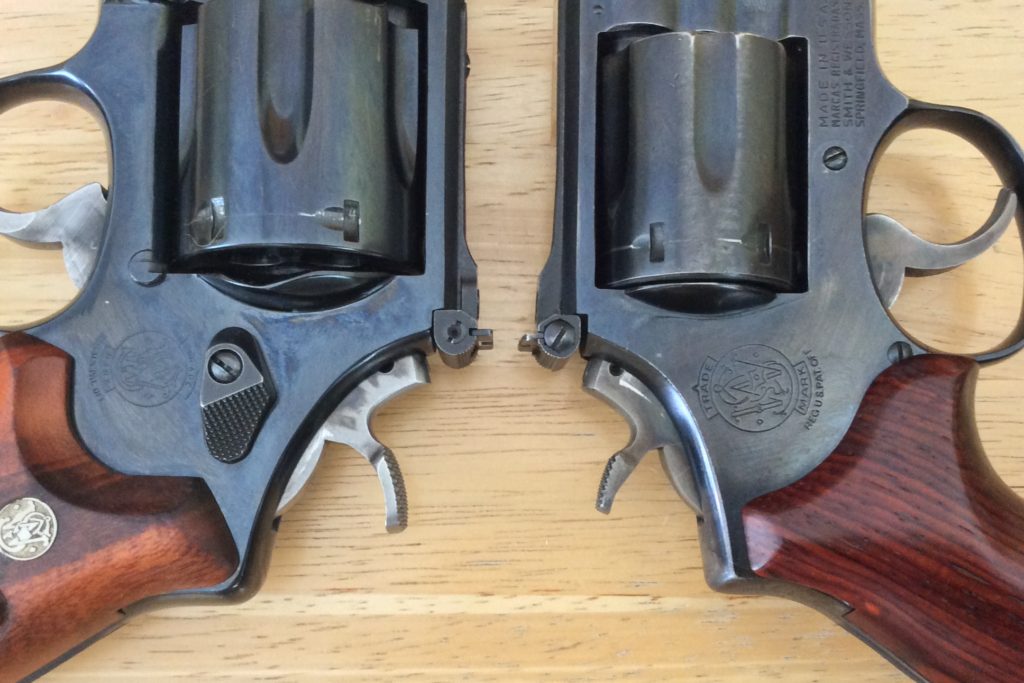
Alternatively, if you were a military or police shooter, you had slightly different needs. Although it might surprise some of the younger RevolverGuys in the audience, single action fire was still popular in many military and police circles up through the late 1960s to early 1970s. However, the oversized target hammers favored by competitors could easily get hung up on clothing or equipment as the weapon was drawn from the holster (and possibly even from concealment), so a hammer spur with a more streamlined shape and reduced size was better suited for service use.
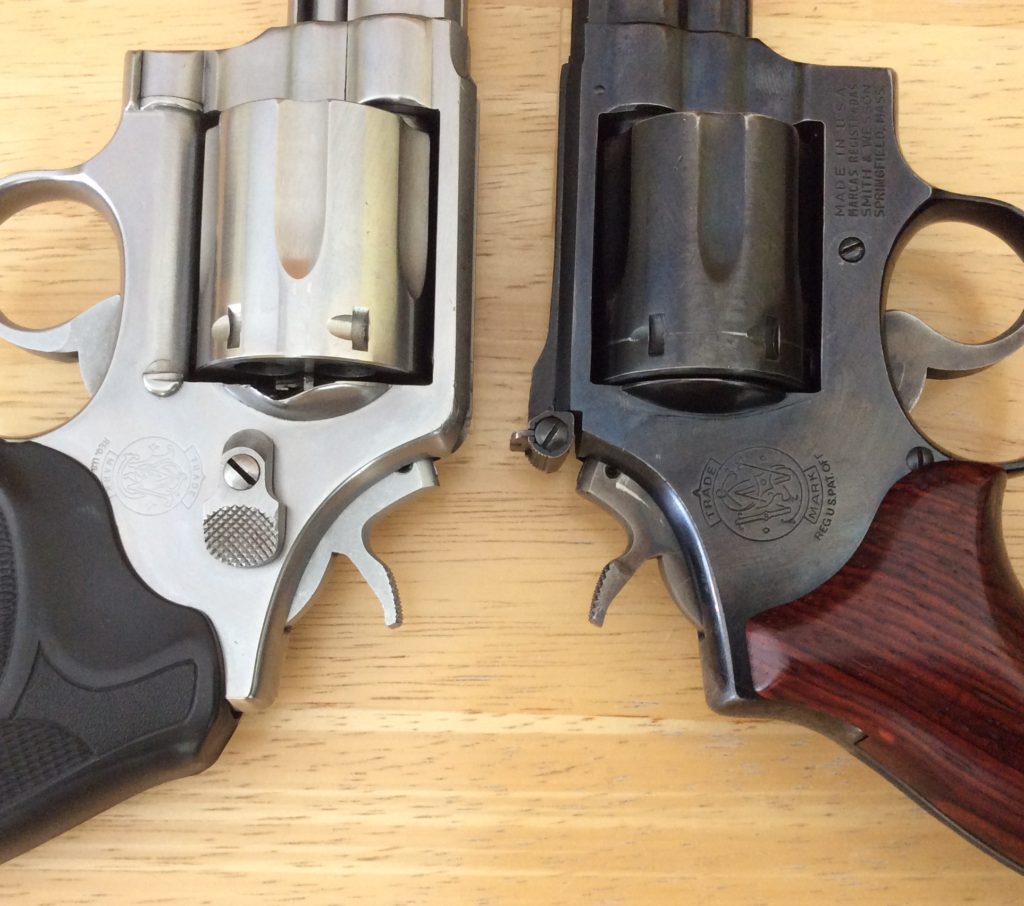
Bang switch
The same concept applied to triggers.
The single action competition shooters benefitted from having wide, flat faces on their triggers, which maximized contact and enhanced the ability of the fingertip to push the trigger straight to the rear for the best X-count. To ensure that the fingertip didn’t slip as the trigger moved (thereby disturbing sight alignment) it helped to machine grooves into the face of the trigger. Target triggers with these features were featured on all the best competition guns from the major makes.
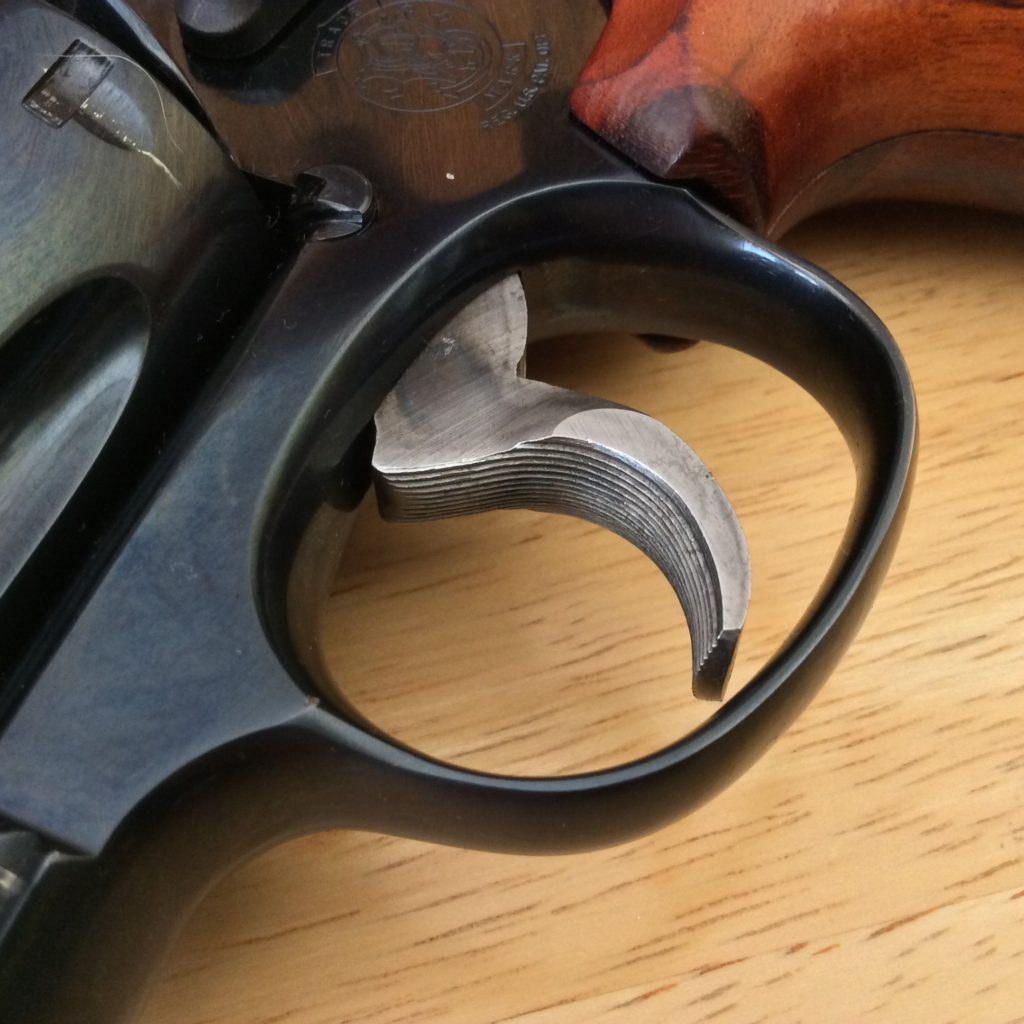
The target triggers were pretty lousy for double action work, however. The wide, flat, grooved trigger face works great if your contact point is the fingertip, but if your contact point is the distal crease of the trigger finger, then you need a different shape for the best performance. When you’re putting the “power crease” (as my friend Mas Ayoob calls it) of the finger on the trigger, you need a narrow trigger face for best control and comfort. Also, having a rounded and smooth trigger face will allow your trigger finger to “slide” across the surface as it’s stroked to the rear. As such, the service guns carried in duty holsters back then were frequently equipped with very different triggers than the target guns.
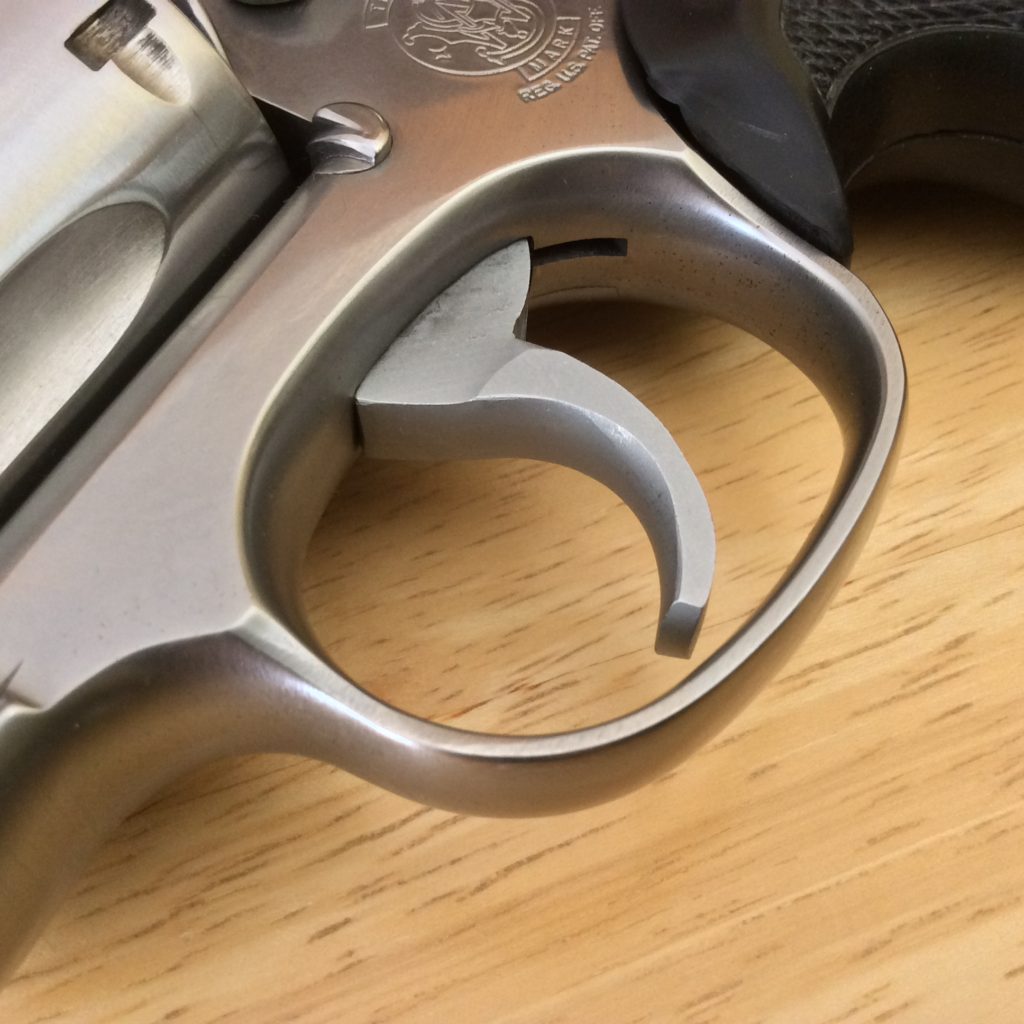
Glory days
In the good old days of yore, manufacturers like Smith & Wesson anticipated the roles that their guns would be used in, and equipped them with hammers and triggers that were most suitable for the mission. However, customers (and particularly agencies, which ordered large batches of guns) could special order parts like hammers and triggers from a menu of choices, to equip the gun the way they wanted it.
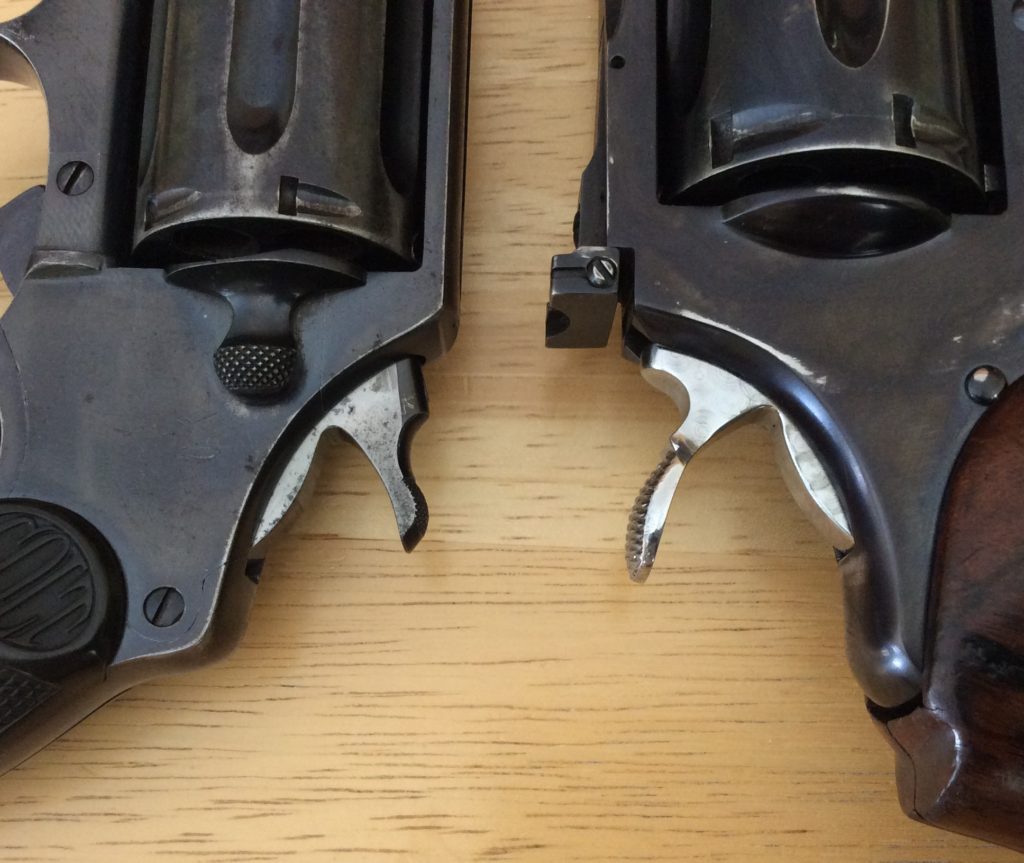
In example, fixed sight guns with shorter barrels (such as the ubiquitous Model 10) often wore “service” hammers and triggers, while the long barreled guns with target sights were equipped with “target” ones.
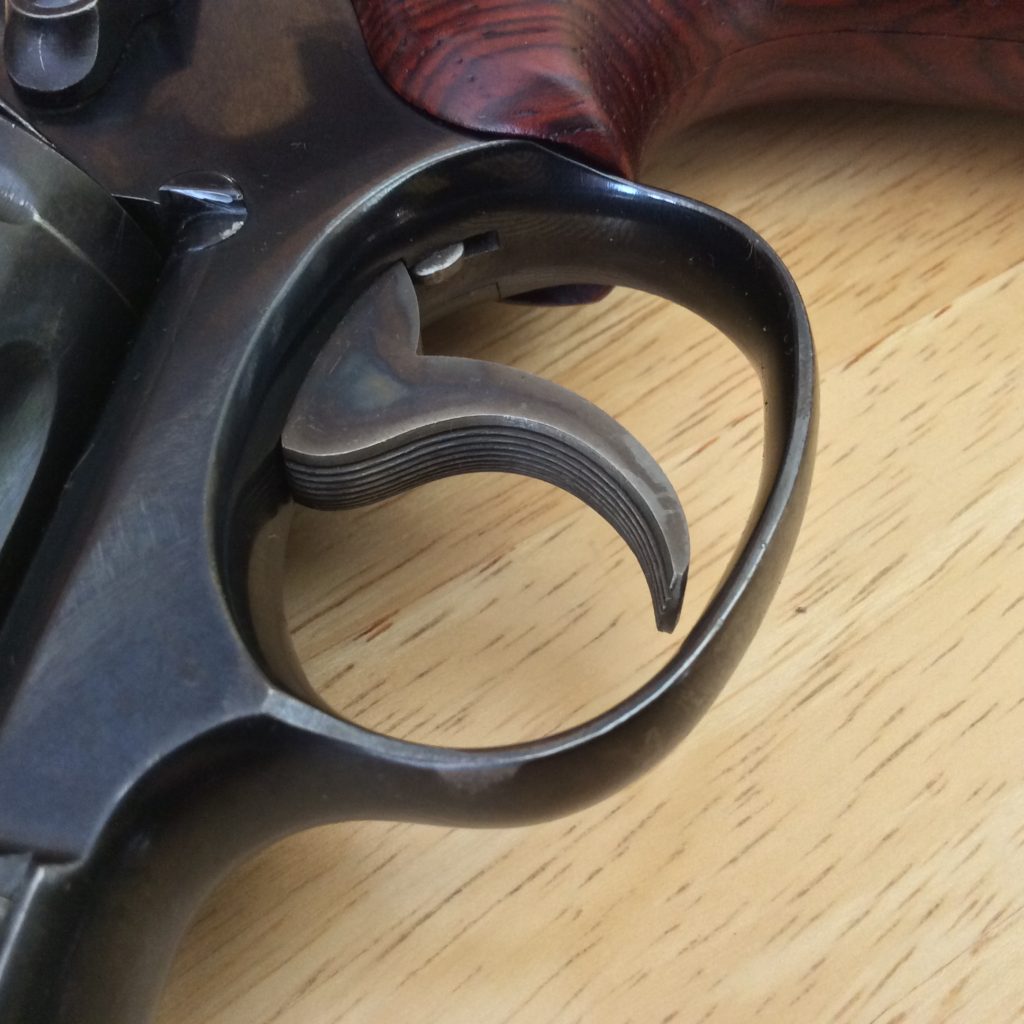
Some guns split the difference between the service and target roles, such as the popular Combat Magnum or Combat Masterpiece series guns, so they were frequently equipped with “semi-target” hammers that split the difference as well.
By the numbers
Using the Smith & Wesson K/L-series guns as a baseline, here’s a look at how the different types of hammers compared to each other:
“Service” hammer: 0.265” wide spur, checkered
“Semi-Target” hammer: 0.375” wide spur, checkered
“Target” hammer: 0.500” wide spur, checkered
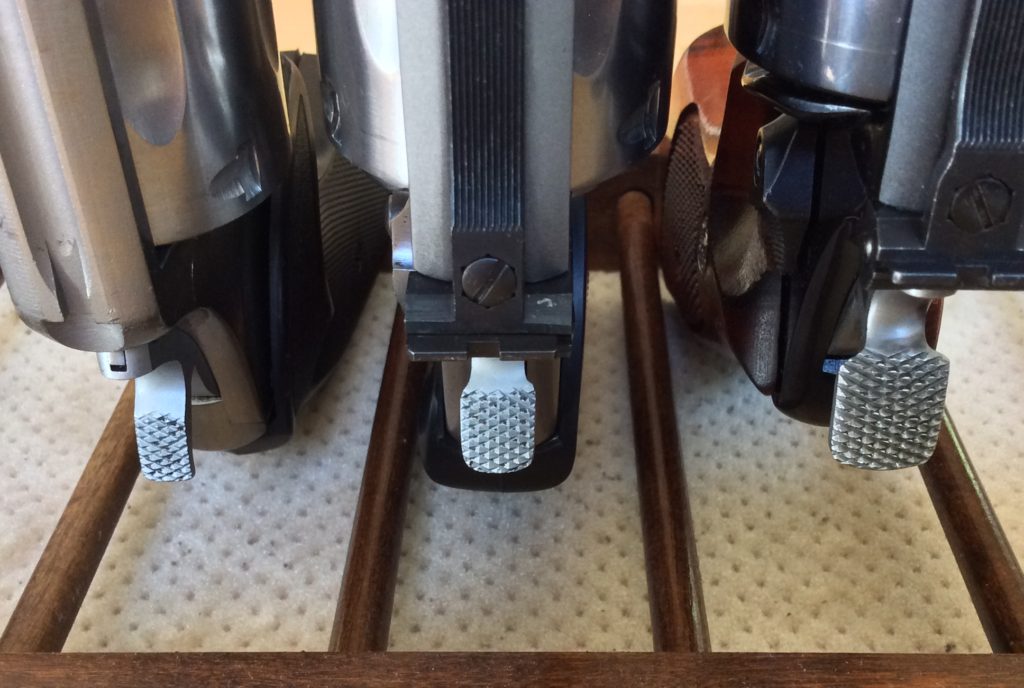
Similarly, here’s how the different K/L-Frame triggers compared to each other:
“Service” trigger: 0.265” wide, grooved face
“Combat” trigger: 0.312” wide, smooth face
“Target” trigger: 0.400” wide, grooved face
The dimensions for the larger N-Frames or smaller J-Frames differed, but a similar menu of choices awaited the owners of those firearms.
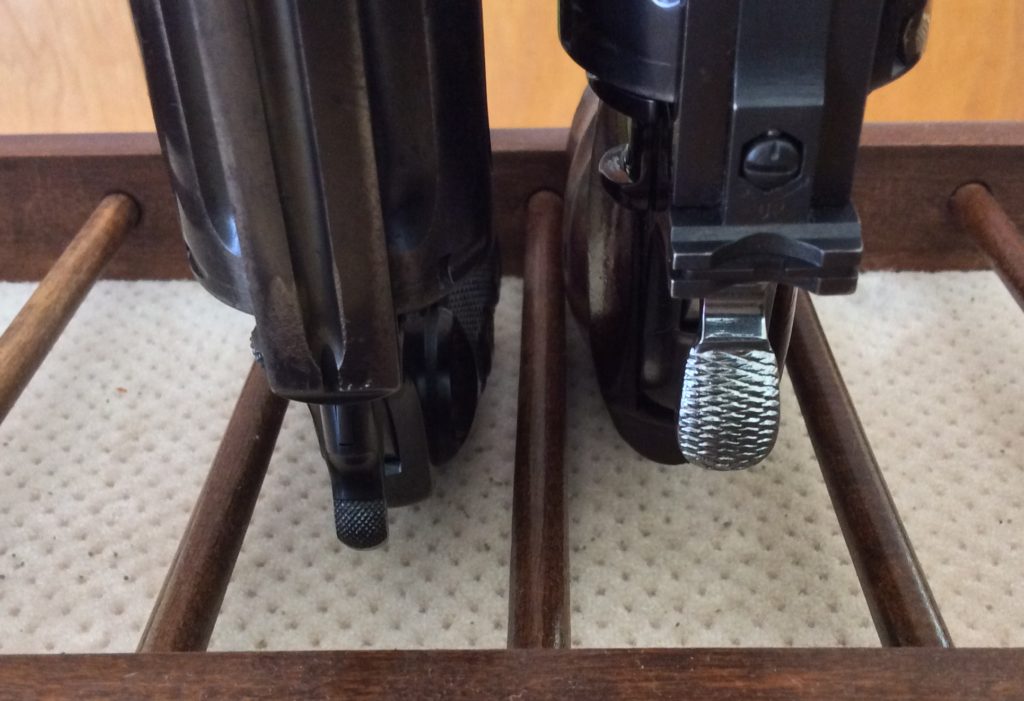
No soup for you!
We don’t have the range of hammer and trigger choices today that our grandfathers once had. In today’s market, the manufacturers usually make the decision for you, and there are few (if any) options if your tastes run different. Sometimes, all the guns in a given frame size are equipped with similar parts, with compacts getting “service” parts and the heavy frames getting “target” parts.
The days of mixing and matching have pretty much gone the way of deep blue polishes, forged steel action parts, pinned barrels, and recessed chambers. It’s a shame, but it’s also an opportunity for someone to jump into the market and fill the gaps. In the modern age of computer aided design (CAD) and computer numerical controlled (CNC) machining, there’s still hope that a motivated entrepreneur will give us RevolverGuys some extra choices.
A RevolverGuy can dream, can’t he?

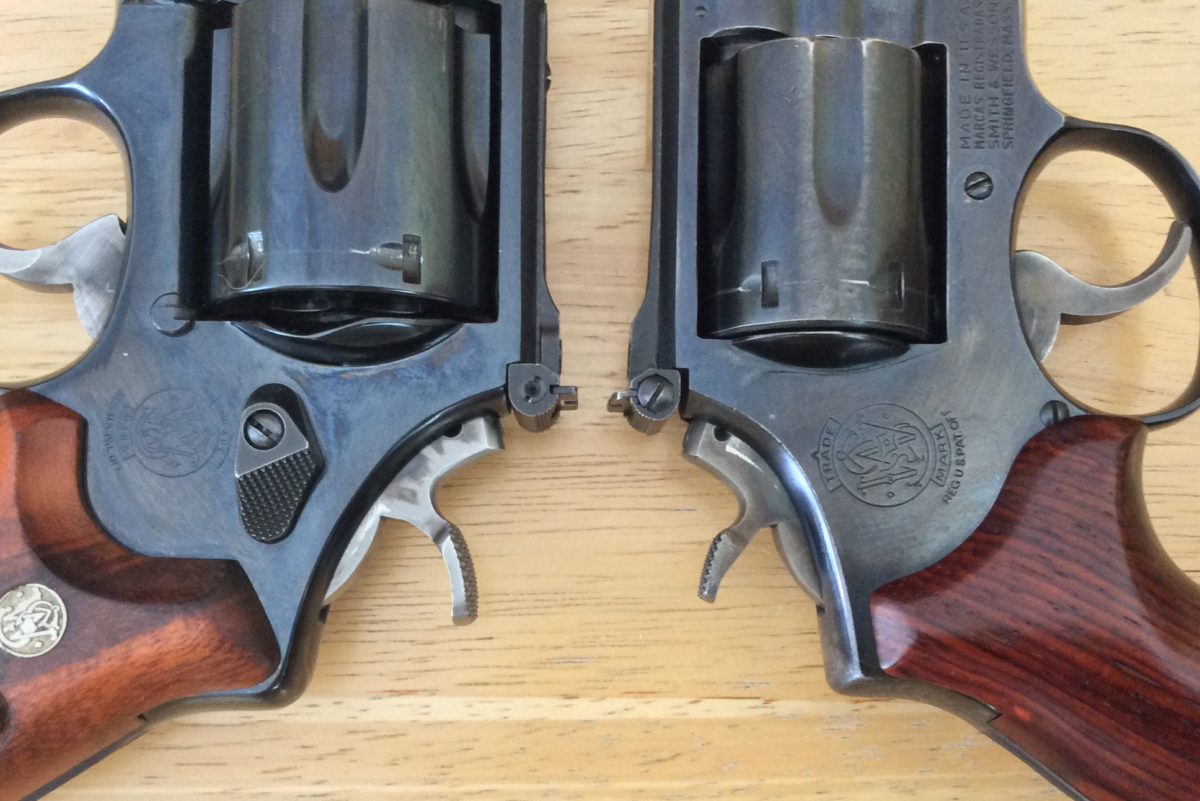
Of course, back in the day, the rule could be
have Dremel tool, will modify trigger.
Sometimes I’d just break the sharpness of
the serrations on a Smith trigger, other
times I’d go further and smooth them off
altogether (not sure that was good for
the strength of the trigger). And one time
I attacked a wide target trigger and flattened
the serrations and rounded very much the
edges. If I recall correctly, at one time I
actually had a smoothed factory target
width trigger for an N-frame.
While I like the smooth triggers offered by Smith
nowadays (basically since 1982), I can live with
the serrations. I understand Jerry Miculek likes
the serrated trigger as he zings out 6 shots in
“minus 3 seconds.”
With the target hammers, sometimes putting a
aftermarket stock on the gun effectively turned
the gun into a double action only revolver! The
hammer wouldn’t lock back unless the stock was
modified or the bottom edge of the hammer was
modified. This was on stocks with a “hump”
filling the curved backstrap.
For double action shooting, I think Smith has hit
a nice compromise with its smooth triggers today
and yet they are fairly compatible for the occasional
single action shot.
Thanks Ed. Great stuff! My personal preferences run towards semi-target hammers, and service or combat triggers that have been rounded and polished smooth. I generally don’t like serrations, but have left them on a few guns that are used just for fun. On a serious gun though, the serrations must go, and the trigger must be rounded and polished. Even the smooth combat triggers have square edges that need attention, as you noted.
Really interesting. I was vaguely aware of the difference in hammer sizes/shapes, but it never occurred to me that they were options. I just assumed that certain guns had certain features or that guns of a certain age had certain features. It seems like it shouldn’t be that hard to make all hammers and triggers target versions and then just remove any extra material if a customer wants something smaller, but the extra step probably isn’t worth it if you are trying to serve the bottom line instead of customers. Too sad.
For the most part, you’re right Greyson. Certain guns did have certain features as a general rule, but once in a while a different part would get substituted on a special distributor or agency run, or by an individual customer. Back when the parts were plentiful, it was no big deal to swap them out. Today, the original pre-MIM/lock parts are getting scarce.
Yet another good read. Keep up the good work!
Thank you Sir! More to follow!
Good read. Took me back in time when I bought my first handgun…S&W 19 on my 21st bday. It had the Target Trigger, Target Hammer and Target Sights in that blue lined wood box. I didn’t know at the time that you weren’t supposed to shoot DA with the TT, so that’s the way I shot it. I did polish the grooves out, but left the width alone. Still the same almost 40 years later!
Sharp-eyed RG readers will recall seeing that gun in these pages!
Couple other points:
The photo showing the combat smooth trigger for
a Smith dates to post 1982 and the thing I hated
about them was the sharp, knife-like edge at the
top of the trigger. Sometimes my finger would
be pinched or cut so I usually Dremeled the
front forward top edge (part that almost goes
into the frame) and its corners.
And the other point is the picture of the Colt
Police Positive hammer, which is so typically
rust scarred or pitted. Colt’s in the raw
hammer sides always seemed to pick up enough
moisture, hand salt to make them less than
pretty. I don’t know when I’ve seen a Detective
Special, for instance, that didn’t have that
“salty” look.
No revolver for you! Love the Soup Nazi reference! I must say I too prefer smooth triggers, but never gave much thought about which hammer. Most of my experience is with service hammers but I do have one of the early Smith 610 revolvers (fluted cylinder) with what I found at the time to be a surprisingly large hammer spur. Clearly the target version, and I like it fine. Of course with a 6.5 inch full lug barrel it is in proportion to the weapon!
“The target triggers were pretty lousy for double action work”
That’s an understatement if there ever was one ! Like others that have posted, I would totally radius the trigger, something of an elliptical pattern, no serrations, and attention to rounding and polishing the sides of the trigger.
If you have set the polish up right on the double action contact surfaces of the hand, the hammer and trigger, couple that with a well radiused (and polished) trigger, you can stage the the double action to feel (and hear) the cylinder bolt dropping onto the cylinder and engaging the lock notch on the cylinder.
With a Colt D/A, you just slide the booger hook onto the bang button and yank it as it stacks.
IME, a well tuned D/A S&W will beat a D/A Colt seven times out of five.
“With a Colt D/A, you just slide the booger hook onto the bang button and yank it as it stacks.”
Haha! It’s not that bad, but it certainly requires a different method to run the snakes and ponies! RevolverGuys definitely tend to develop a preference for one or the other, with most leaning your way. Remember the “Smolts” from yesteryear? Mating a Colt barrel to a Smith & Wesson action took a lot of work, but afficionados swore they were getting the best of both worlds by doing that.
Makes me think of Cirillo’s “Smith and Dan” thingies….He sure loved them.
Remember them well. Colt Python barrels fitted to S&W (usually) K frames. Cylinder crane would have a ball detent fitted since there wouldn’t be the lock on the ejector rod.
They shot exceptionally tight groups mainly because the Python barrels used a 1:14″ twist instead of S&W’s standard 1:18.75″ twist. PPC guys obviously liked that part. Why S&W and Ruger stick with that slow twist rate is beyond me.
The Python barrel bores were polished to mirror perfection – I’ll give Colt that, they did a great job there. Of the four Pythons I’ve had over the decades, they all shot exceptionally well.
Also, IIRC, the bore diameter on Python barrels actually tapered slightly tighter by 0.001″ from forcing cone to muzzle. Supposedly that gave a little extra rifling engagement.
Alas, the young millennial types who’ll may never have the joy of such a well made revolver (Python), and the challenge of finding a revolversmith who can keep one back in correct timing.
Amen, brother! I wouldn’t know where to send somebody if they had a Python that needed help these days. All the greats are gone. I’d probably entrust it to Bill Laughridge and crew at C&S.
I am fortunate to own a Python, but have only shot a few .38 wadcutters out of it for just that reason. Parts are not easy to find and there seem to be very few gunsmiths who know how to work on them.
C&S has a great reputation and the wait times to show for it. I have also heard good things about Scott Glenn. When I called the Colt factory a few months ago they said they no longer serviced any revolvers except the SAA, and referred me to The Custom Shop in Hamilton, Montana.
Best,
Paul
Great references, Paul! Thanks!
Real interesting information, lotsa things I never considered. DA revawvers, I pretty much just took what came and didn’t think about it–except to maybe replace spurred hammers with spurless for pocket carry. Even took the garage grinder to a couple of spurs, which look icky but do the job. I do have a .45 Colt-caliber Ruger Blackhawk that a friend replaced the sharp original hammer with a flat Vaquero hammer; makes it easier to cock, and doesn’t dig into the love handles when carried in the rancher rig. Ace
I used to fit Super Blackhawk hammers on Blackhawks . . . changed the feel of it and made cocking it a cinch.
Now I’m going to have to check the three revolvers we own. I suspect that they all would be considered “Duty” hammers and “Combat” triggers.
Mike, thanks for the lessons, because I never knew this bit of revolver history before.
My pleasure guys! Glad you enjoyed it!